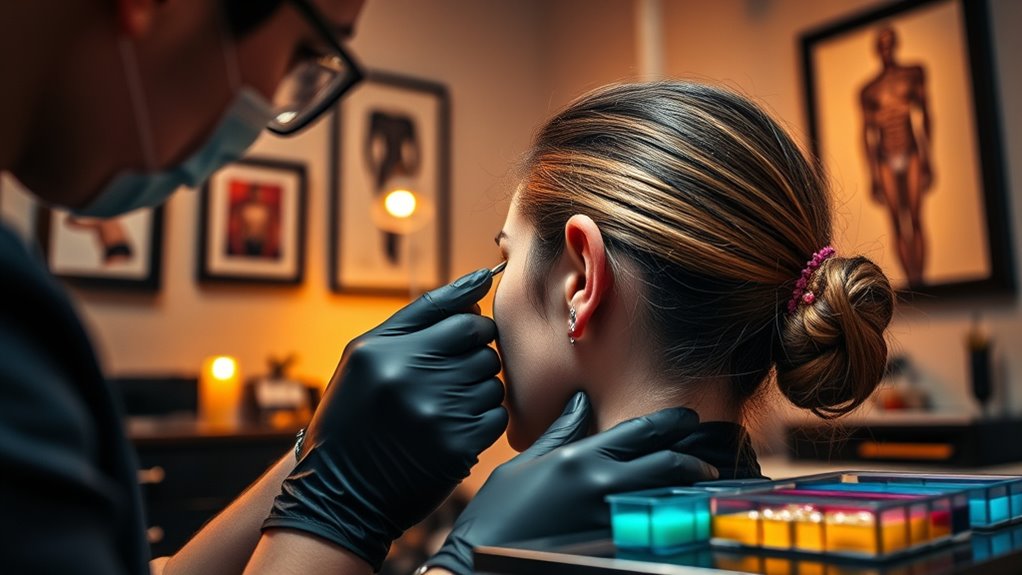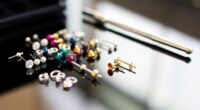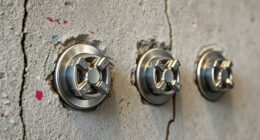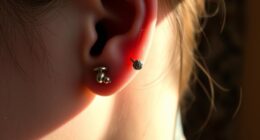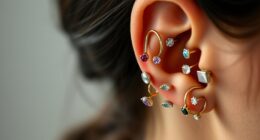Inside a piercing studio, your day starts with thorough cleaning, sterilizing tools, and organizing your workspace to guarantee safety. You greet clients, discuss their ideas, and explain the procedure clearly. With careful hygiene, you prepare the area and use precise markings before piercing. Throughout the day, you balance technical skill with client reassurance, maintaining a spotless environment. Keep going to discover more about what makes a professional piercer’s routine so meticulous and safe.
Key Takeaways
- The day begins with thorough cleaning, sterilization, and preparation of tools and workspace to ensure a sterile environment.
- Client consultations involve discussing preferences, medical history, and explaining procedures to ensure comfort and understanding.
- Piercing procedures require precise placement, sterile techniques, and maintaining focus to ensure safety and accuracy.
- Throughout the day, the studio remains disinfected, and customer interactions prioritize reassurance and effective aftercare guidance.
- Proper hygiene, sterilization, and environment management build trust, ensuring safe piercings and positive client experiences.

A typical day at a piercing studio is a whirlwind of preparation, precision, and customer interaction. You start your morning by thoroughly cleaning and organizing your workspace, guaranteeing that everything meets strict standards of studio hygiene. Every tool, surface, and piece of equipment must be sterilized and ready to go. This isn’t just about following regulations; it’s about creating a safe environment for both you and your clients. You double-check your autoclave, make sure disposable needles are sealed and sterile, and prepare gloves, antiseptics, and cleaning solutions. Maintaining impeccable studio hygiene isn’t optional—it’s vital for preventing infections and building trust with your clients.
A clean, sterile workspace is essential for safe, trust-building piercings.
Once your station is set, the day kicks off with client consultations. When someone walks in, you greet them warmly, ready to discuss their piercing ideas and address any concerns. A good consultation involves asking questions about their medical history, previous piercings, and skin sensitivities. You explain the procedure step-by-step, guaranteeing they understand what to expect, and you listen carefully to their preferences. This helps you recommend the best jewelry, placement, and aftercare plan. It’s important to make clients feel comfortable, especially if it’s their first piercing. Clear communication reduces anxiety and sets the stage for a positive experience.
As clients sit down, you prepare for the actual piercing. You wear gloves, clean the area thoroughly with antiseptic, and double-check the placement using a gentle pen or marker. Precision is vital—misplaced piercings can lead to discomfort or rejection. You take your time, ensuring the positioning is perfect before proceeding. During the piercing, you stay focused, steady, and mindful of maintaining the highest standards of hygiene. Afterward, you clean the area again, provide aftercare instructions, and answer any questions. This ongoing interaction helps clients feel supported and informed.
Throughout the day, you repeat this cycle—consultation, preparation, piercing, aftercare—while keeping your studio spotless. Managing studio hygiene with meticulous attention guarantees every client leaves with a safe, clean piercing and a positive impression. You’re constantly balancing technical skill with customer service, making sure each person feels valued and cared for. By the end of your shift, your workspace is disinfected, tools are sterilized, and you’re ready to start fresh the next day. This routine, grounded in hygiene and clear communication, defines your role and keeps your studio running smoothly. Additionally, understanding the importance of color accuracy can help you select the right lighting and tools to ensure precise work and comfortable conditions for your clients.
Frequently Asked Questions
What Safety Protocols Are Most Critical in Your Daily Routine?
You focus on essential safety protocols daily to ensure client safety. Maintaining piercing hygiene is crucial, so you thoroughly disinfect equipment and your hands before each procedure. Studio sanitation is also vital; you regularly sanitize all surfaces and work areas. Using sterile needles and gloves minimizes infection risks. By adhering to these safety protocols, you create a safe environment, protecting clients and upholding your professional standards.
How Do You Handle Clients With Needle Phobia?
Imagine calming a storm into a gentle breeze—that’s how you handle clients with needle phobia. You prioritize client comfort by speaking softly, explaining each step, and offering reassurance. You use anxiety management techniques like deep breathing or distraction. By creating a trusting environment, you help clients face their fears, transforming a potentially overwhelming moment into a manageable experience, and ensuring they feel safe and respected throughout the process.
What Are the Most Challenging Piercings to Perform?
You find certain piercings more challenging due to piercing techniques and healing challenges. Cartilage piercings, like the helix or daith, require precise technique and patience because they often have a higher risk of complications. Surface piercings, such as nape or eyebrow, can be tricky because of their healing process. You must stay focused, use proper tools, and educate clients on aftercare to guarantee successful healing and minimize issues.
How Do You Ensure Sterile Conditions During Each Procedure?
To guarantee sterile conditions during each procedure, you meticulously prepare by sterilizing all equipment and using sterile gloves. You follow strict hygiene standards, including disinfecting the piercing area and avoiding cross-contamination. You also use sterile needles and avoid touching non-sterile surfaces. By maintaining these practices, you minimize infection risks and provide a safe, professional experience for your clients.
What Advice Do You Give Clients for Aftercare?
Many clients worry about piercing hygiene and proper healing tips. To help, I advise you to keep the area clean with saline solutions, avoid touching it with unwashed hands, and steer clear of swimming or submerging it in water. Follow these healing tips consistently, and you’ll reduce infection risk while promoting faster healing. Remember, proper aftercare is key to ensuring your piercing heals beautifully and stays healthy long-term.
Conclusion
So, next time you step into a piercing studio, remember the artist behind the needle is a master of precision and care. They turn a simple piece of jewelry into a work of art, like a sculptor shaping beauty from metal. With each piercing, they create a lasting story etched in skin and memory. It’s more than a job—it’s a craft that transforms moments into lifelong memories, one careful puncture at a time.
I’m Gillian. I love piercings and tattoos- there’s something about the way they make your body look that just makes me happy. I started this blog to share my passion for piercings and tattoos with the world and to help people who are thinking of getting their first piercing or tattoo.
I’ve been writing about piercings and tattoos for a while now on piercings-body.com. I love sharing my knowledge with others and helping people make informed decisions about their bodies.

